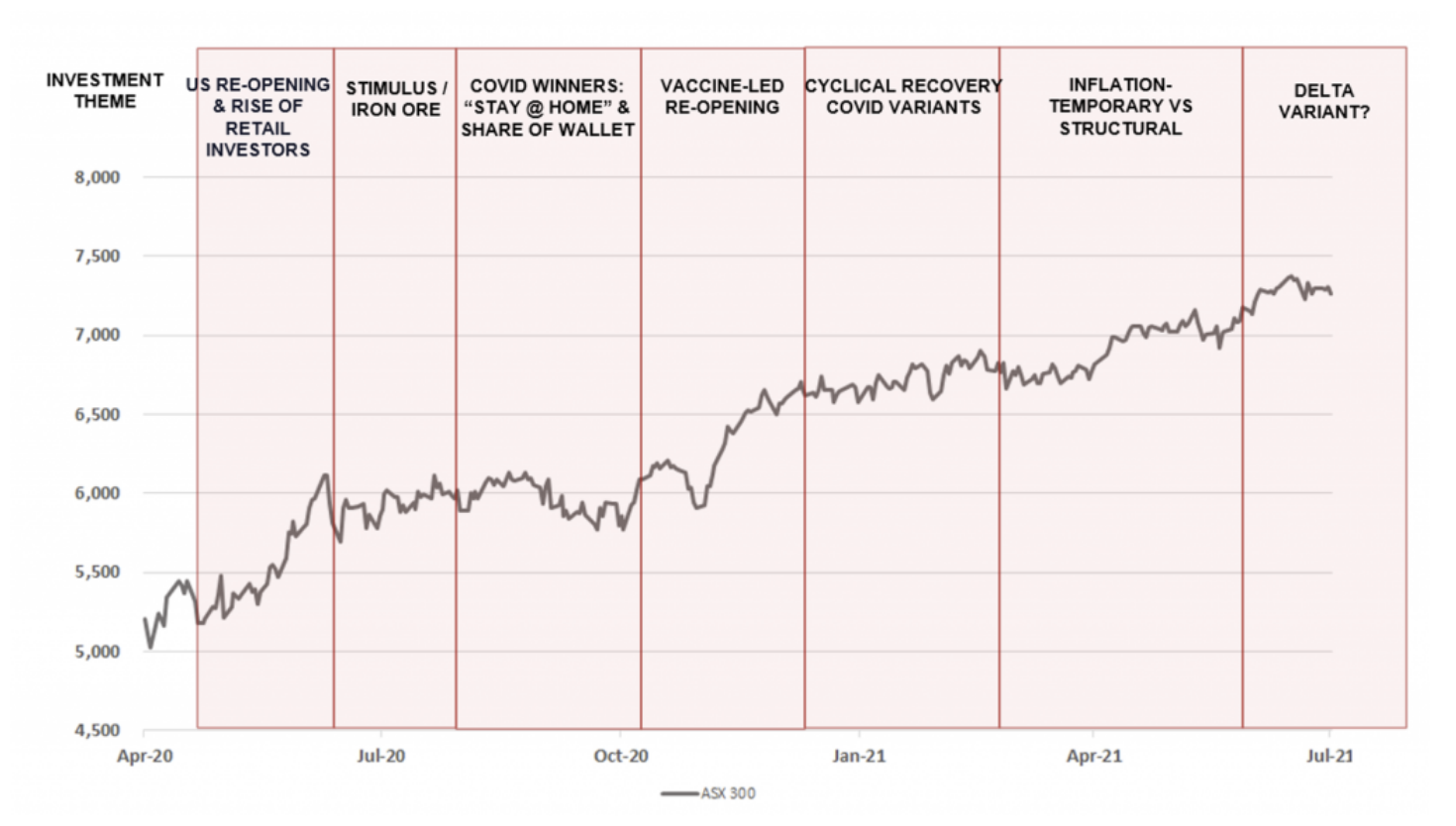What can we learn from the investing themes of FY21?
July is a natural time for us to review the financial year just past – both in terms of The Montgomery Fund as well as the investment journey of the broader market. The 2021 financial year was unprecedented in many ways, not just because the last 12 months has seemed more like an extension of the initial COVID-19 fallout of the June 2020 quarter, but also because of the volatility witnessed in the broader market given the rapid pace of developments in a suddenly “less predictable” world.
2021 characterised by thematic investing
One of the hallmarks of 2021 has been significant rotational moves driven by thematic investing, resulting in an extremely condensed investment horizon for many businesses and stocks. Share price moves were magnified by the surge of new investors – especially in retail – as the cocktail of stimulus checks, closure of traditional gambling outlets and free brokerage fuelled the growth of Robinhood and the like. The internet also allowed for easy dissemination of information for would-be participants, making financial markets more accessible than ever.
This has added new wrinkles to investing such as popular “meme” stocks (Diamond hands to the moon anyone?) while the dangers of shorting were on clear display with moves in Gamestop, AMC Entertainment, Hertz and the like ruining the performance of seasoned hedge fund investors.
The below chart highlights some key themes that dominated the headlines and relative share price performance over the past year. One thing that stands out is just how short some of the dominant narratives held, which had a profound impact on share price performance depending on which theme was “flavour of the month.”
FY21 Investment Journey – dominant investment themes over the past 12-15 months

Source: MIM
As an active portfolio manager, we felt first-hand the significant volatility in some of our positions. This was most pronounced in the month of November, when “Re-opening” trades surged on positive news on the Pfizer vaccine front, while “COVID-19 winners” were sold down heavily. I wrote about this dynamic in November, but it’s worth highlighting again – for example – on 10 November (i.e. “vaccine” day), The Montgomery Fund benefited from large gains in “re-openers” such as Scentre Group, Sydney Airport, IDP Education and Webjet while seeing its positions in “COVID-19 winners” such as Redbubble and Codan record falls greater than 10 per cent (Redbubble was down 20 per cent and Codan was down 13 per cent).
Navigating this dynamic has been extremely challenging as share prices reacted immediately to changes in the news cycle. For example, Redbubble fell to below $4 per share in November 2020 (-20 per cent), only to peak at above $7 per share in January 2021 (+75 per cent). On the flipside, the likes of Webjet rallied more than 50 per cent in November (from $4 per share to $6 per share), only to see it fall more than 20 per cent (to around $4.60 per share) as COVID-19 re-emerged in November / December.
These two examples show how switching positioning aggressively to try and take advantage of short-term momentum may have yielded sub-par results.
The narratives that drove short-term performance
While most of these themes are self-explanatory, a quick run-down of some of these narratives may be useful to highlight the investment journey:
- US Re-opening and the rise of retail investors (May-June 2020) – after the initial flurry toward the tech winners and a flight to quality, late May and June saw these tech winners make way for a strong bid in “re-openers.” This was fuelled by large portions of the US (and parts of Europe) looking to ease lock-down restrictions as the Northern Hemisphere entered summer. After spiking early June, the narrative lost steam with the realisation that COVID-19 was not going away anytime soon, with many of these businesses continuing to burn cash. This period also heralded the introduction of new investors in a meaningful way. Robinhood investors made their presence felt – buying popular stocks such as Tesla, but also following the thematic trends as airlines and cruise operators were aggressively bid (and we also saw the bankruptcy boom).
- Stimulus / Iron ore rally (July-August) – As the world came to grips with rising COVID-19 cases with re-opening, the focus shifted to fiscal stimulus programs. It was around this time that the iron ore price first gained major steam, with China focusing on stimulating the “old” economy (infrastructure / property) given challenges in the services sector due to COVID-19. Supply side narratives helped, as COVID-19 rampaged through Brazil leading to significant price moves relative to supply disruptions. Not well established at the time was the fact that the world was undergoing a manufacturing boom, as “stay-at-home” orders supplemented by unprecedented fiscal support compounded the “share-of-wallet” in goods over services.
- COVID winners, the “Stay-at-home” trade (August – November) – Markets by now had a better understanding of how COVID-19 was impacting society. Many of the dynamics experienced in Australia – such as share of wallet to goods, fiscal support supplementing incomes, the rise of e-commerce, home improvement spending, work-from-home dynamics etc were felt around the world. This period was dominated by perceived COVID-19 winners – especially during reporting season – which quantified the benefit of accelerating sales in May / June, with no slowdown in sight in August. Both large and small cap winners featured here – sharing common characteristics such as tech, e-commerce, home improvement, retail spending etc. On the flip side, this period saw “re-openers” sold heavily from June peaks – while positive developments on vaccine safety continue to trickle out, there was still enormous uncertainty on efficacy, not just effectiveness but duration – during a period where COVID-19 case loads were accelerating around the world.
- Vaccine-led reopening (November – December) – The most notable rotation event, as the market took an overwhelmingly positive view on the Pfizer – BioNTech vaccine news, with the “end” of COVID-19 presumably in sight. I have already written about this rotation – although with the added benefit of hindsight, it was clear that vaccine roll-outs would take time and re-opening would not be a smooth journey for most countries (as Australia is finding out).
- Cyclical recovery and COVID-19 variants (December – February) – The good news from the vaccine quickly made way for a new “reflation” narrative – record stimulus, economic recovery and an “end” in sight for severe lockdowns – with manufacturing leading the charge. The confidence in future recovery was little dented by a resurgence of COVID-19 in the Northern Hemisphere.
- Inflation – temporary or structural? Positive reflation narratives quickly turned to concerns around overheating as the US 10-year yields surged almost 80 basis points (from 0.9 per cent to 1.7 per cent) from early January to late March. The rally in every commodity added fuel to the narrative as financial markets bid up futures in commodities with genuine shortages such as lumber (+168 per cent), infrastructure bill beneficiaries such as US steel (+74 per cent), new energy narratives such as copper (+39 per cent), drought impacted soft commodities (corn, soybean, wheat) and more recently oil. Surprisingly, the only major commodity that had failed to catch a material bid was gold, which in the past had been seen as the ultimate store of value.
What does the future hold in FY22?
Even with the rise of the Delta variant, the relative familiarity of COVID-19 – aided by society’s ability to adapt quickly to the challenges presented by the pandemic – has meant markets have for the most part been willing to look beyond short-term disruptions.
Despite currently being under lockdown, I share the investor optimism on an eventual return to “normal” in the next 12 months and looking forward to an overseas holiday.
Not an existing Livewire subscriber?
If you're not an existing Livewire subscriber you can sign up to get free access to investment ideas and strategies from Australia's leading investors.
And you can follow my profile to stay up to date with other wires as they're published – don't forget to give them a “like”.
3 topics
5 stocks mentioned

